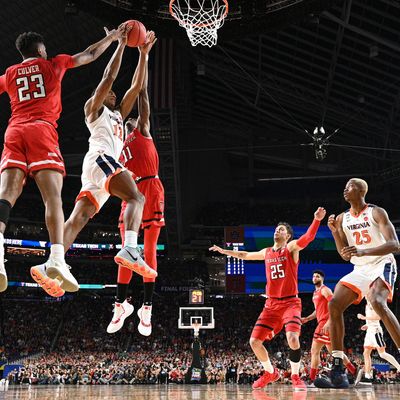
One of the primary reasons sports have survived — if not exactly thrived — during the pandemic is that leagues and teams learned to be flexible. The NBA, WNBA, and NHL constructed bubbles; the NFL started playing games on Tuesdays and Wednesdays; Major League Baseball slashed the season down to 60 games. These arrangements were hardly ideal, but it’s difficult to claim they weren’t successful. You can argue the leagues shouldn’t have forced through their season in the midst of everything, but the history books will note that there was in fact a World Series, an NBA and WNBA Finals, a Super Bowl, and a Stanley Cup 2020. Almost everyone pulled it off.
The one North American sports staple that didn’t survive was the NCAA Tournament. The timing of the pandemic’s assault on America never really gave it a chance. To look back at the circumstances of the cancellation of the 2020 tournament is a reminder, one year later, of just how quickly everything changed. On March 9, Duke played in front of tens of thousands of fans in the ACC Tournament; on March 10, the Ivy League canceled its postseason tournament (a move that was widely mocked), but assured fans that regular season champion Yale would still play in the NCAA Tournament; on March 11, St. John’s and Georgetown were playing at Madison Square Garden as then-President Trump addressed the nation; on March 12, the NCAA Tournament was canceled. Other sports were able to pause their seasons and regroup when more was known about COVID-19. College basketball had no such luxury. It was over like that. No bracket pools, no March Madness, no Final Four, no “One Shining Moment”:
(The song is so terrible, and it’s still hard to not cry like a baby every time.)
The cancellation of the tournament meant a jaw-dropping loss of $700 million in revenue for the NCAA, a cataclysm that would turn into an extinction-level event if it were to happen again in 2021. And so here we are. We’re a few days out from Selection Sunday, the release of the brackets for the men’s NCAA Tournament (the women’s tournament bracket comes out on Monday), and then, next week, they’re going to give this thing another go. March Madness has returned. But it remains, even with the improving nature of the pandemic nationwide, an extremely perilous proposition.
College basketball has muddled through this regular season, with an estimated 20 percent of games being canceled and a few teams ending their seasons early or opting out entirely. Hall of Fame coach Mike Krzyzewski openly questioned whether the season should be played at all, and that was before star Florida player Keyontae Johnson, who had just recently recovered from COVID-19, collapsed on the court in the middle of a game. (His family later said the episode was not COVID-related, but it sure felt that way at the time.) The sport, lacking a clear leadership structure, ended up making up rules and protocols as it went along. At one point, Gonzaga, the No. 1 team in the country, had a player and staffer test positive the day before a game and went ahead and played anyway. But No. 2 Michigan had to pause on all activities for two weeks when one of the new COVID variants was found on campus — even though the team itself didn’t see any positive cases. Some teams played as many as 28 games; some played as few as five.
But none of that really matters as long as the tournament happens; the rest of the sport’s revenue is negligible compared to the avalanche of money made in March. The tournament is the only college basketball event anyone other than diehards (like me) pay any attention to; I’d be surprised, frankly, if most non-college basketball fans have thought about the sport since they last filled out a bracket back in March 2019. The tournament must be protected.
So the NCAA has taken extreme measures this time. Unlike in past years, the tournament is taking place in one location, Indianapolis (and the surrounding areas of Bloomington and West Lafayette) to best simulate a bubble environment. And for the first time, the NCAA is setting up backup teams. When the pairings are announced on Sunday, the first four teams left out of the tournament will also be unveiled. If a team in the tournament experiences an outbreak between Selection Sunday and Tuesday night — a small window, to be sure — a replacement team subs in. (This leads, inevitably, to the uncomfortable dynamic of a few teams’ fans actively cheering for another team’s players to get sick.) And if an outbreak hits one of the 68 rosters after Tuesday? The unfortunate team will just forfeit the game entirely, and their opponent will advance. This situation already played out in last week’s conference tournaments: Both Holy Cross and Northern Iowa’s seasons came to an end because of positive tests within the program. If you consider how many cancellations there have already been — and then look ahead to a tournament that consists of 68 teams packed with 18- to 23-year-olds, playing in front of indoor crowds — it becomes clear that the odds are in favor of some sort of disruption, not against it.
You might want to keep that in mind when filling out your brackets. You need to take into account not only every team’s zone-defense principles and ability to execute the pick-and-roll; you need to know how well they handle quarantine as well. Heck, maybe research can help you there too. Houston coach Kelvin Sampson, whose team is likely to be a No. 2 seed, said earlier this year that his entire team has had COVID. If you believe the increasing evidence in favor of extended immunity, heck, they’re a value pick!
I invoke such twisted, borderline-depraved logic not to provide actual bracket advice — Houston’s overrated anyway — but to point out the moral hula hoops everybody must jump through just to try to enjoy something that, until now, has mostly been a unifying, silly, harmless event. College basketball is overflowing with problems, and the NCAA Tournament (and its “Corporate Champions,” a depressing euphemism broadcaster CBS uses for “premium commercial sponsors”) is foremost among them. But for the casual and hard-core fan alike, the virtues of the tournament — its unpredictability, its ever-refreshing storylines, its fusing of a sport ruled by territorial pride and parochialism with the national stage, the perfection of the bracket itself, that stupid, wonderful song — have always outweighed its failings. Still, it’s one thing to make your peace with a league in which the players earn nearly a billion dollars a year for universities and institutions that don’t pay them; it’s quite another to justify things when entire top-ten teams are contracting the virus. The moral calculus can’t help but shift.
Listen: I cannot wait for the tournament to start. March Madness is my favorite sporting event, and it’s elevated this year by my beloved Illinois Fighting Illini’s status as a presumed No. 1 seed. I was forlorn when last year’s tournament was canceled, and realize that a 2020 repeat might just kill off the sport forever. But there’s no question that, with the stakes this high, the NCAA is making some compromises. The NCAA is hopeful they will be able to pull off this 68-teams-in-one-small-city experiment without the whole thing collapsing. I’m hopeful, too. But just because the end of the pandemic looks to be in sight, that doesn’t mean the tournament isn’t a high-wire act. In just a few days, beyond the excitement of March Madness itself, the NCAA is basically putting its entire financial future on the line. One Shining Moment, indeed.






























